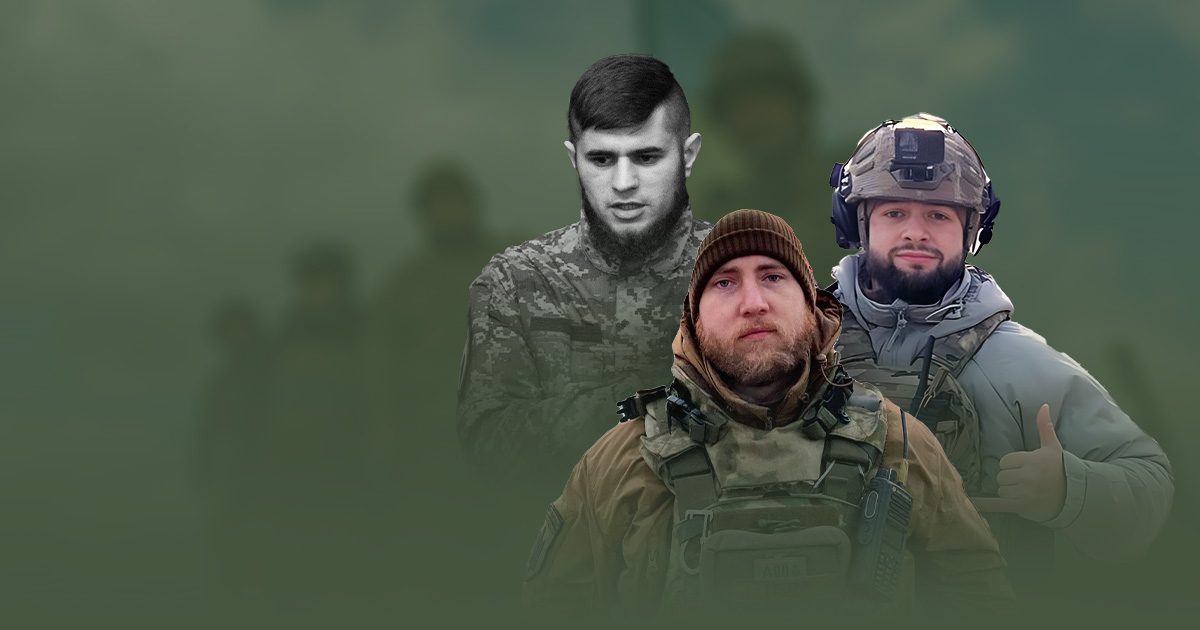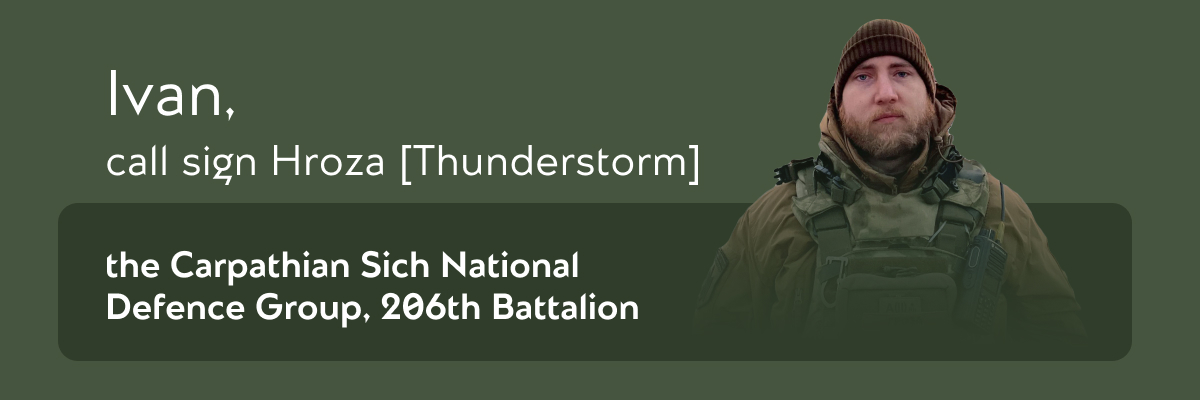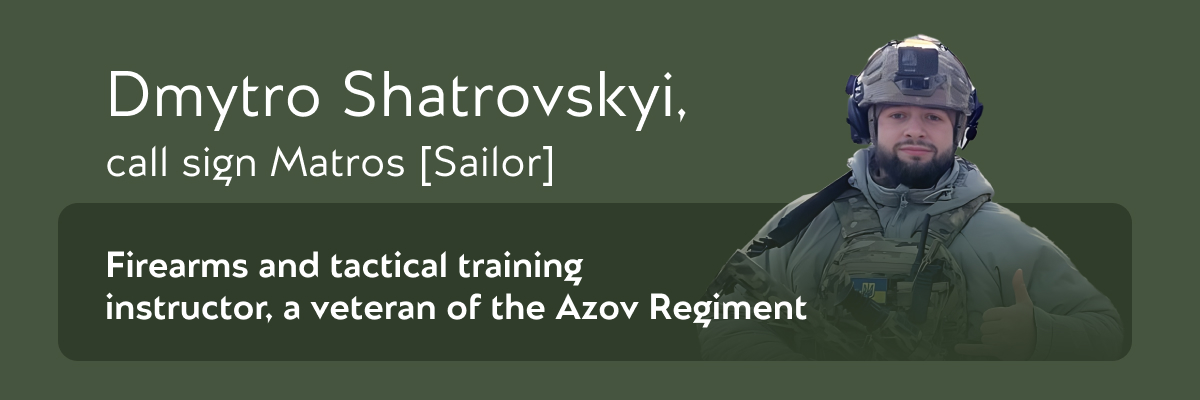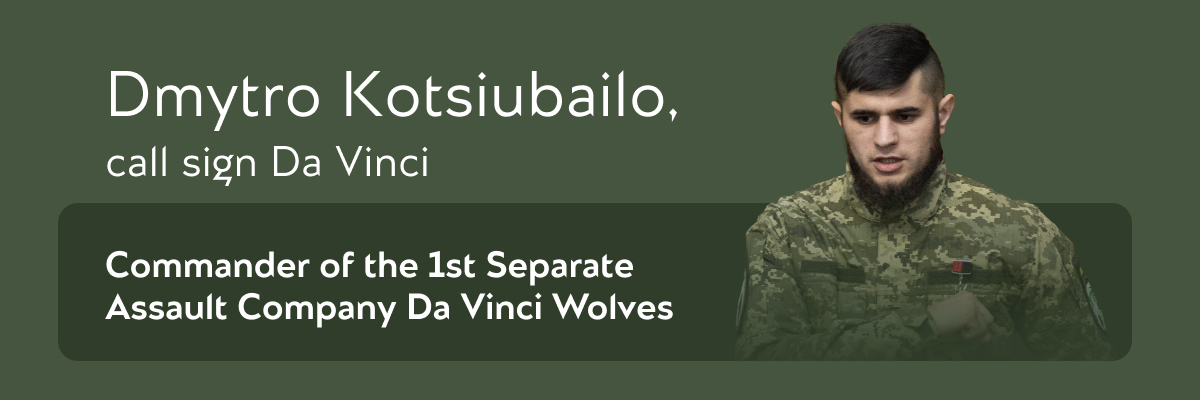"My main thought was: "Death, please, not today": military volunteers about the ninth year of the Russian-Ukrainian war

On 14 March, Ukraine celebrates the Day of the Ukrainian Volunteer. On this day in 2014, the first 500 military volunteersof the Maidan Self-Defence went to the training base in Novi Petrivtsi from Maidan Nezalezhnosti to form the first volunteer battalion.
We talk about the Ukrainian military volunteers, how the Russian-Ukrainian war began for them in 2014, what changed them, and what they are fighting for.

The soldier first went to war in the summer of 2014 when he was a second-year history student. Then he joined the Ukrainian Volunteer Corps, after which he was sent to a military training ground, where he underwent training for about a month.
"I waited for the summer holidays and told my parents I was going to a military training camp, but later my father found out where I was going. The hardest part was when I decided to call and sign up for the Volunteer Ukrainian Corps," says Hroza.
At first, the soldier was assigned to guard checkpoints in the Donetsk region, and later he was sent to Pisky in the Donetsk region. At the time, the guy was 19.
"In October 2014, I returned to Ivano-Frankivsk and continued my studies. Later, together with a group of like-minded people, I founded an organisation in the city that provided military training for young people. We decided that it was necessary for the members of the organisation to gain military training," the soldier says.
In the winter of 2017, the Carpathian Sich combat group moved to Mariupol, and from there, they took up their post at the line in Shyrokyne, Donetsk region.
In February 2022, the organisation in which Hroza was involved held a massive military training class for all interested. On 19 February, the last training session before the full-scale war was held.
"On 24 February, I was awakened by a call at 6 am and realised it had started. On 27 February, we got to Kyiv, where we joined the territorial defence forces. We performed combat missions in the village of Gorenka, near Gostomel. On 6 March, the commander of our group, Kyrylo Cobra Babentsov, was killed in Hostomel," Ivan says.
After the de-occupation of Kyiv region, the unit was transferred to Kherson region until October.
"The hardest part was when the counter-offensive began, the battalion suffered the biggest losses of all time. A week before the liberation of Kherson, our unit was withdrawn from that area," the machine gunner said.
After the 206th Battalion was restored, it was sent to Kharkiv region, and from there to the Bakhmut area, where it has been stationed ever since. According to him, this is the most challenging period in the war for him.
"Hroza says what surprised him the most about the war was the large number of Ukrainians who took up arms.
"I was surprised by their ability to adapt to the living conditions. During this time, we had to live in basements, under a bridge in a canal, and in trenches. Unfortunately, the war also turned human death into an everyday, commonplace occurrence," he says.
Describing the most memorable moment of the war, Ivan recalls the story of how Ukrainian positions were smashed by Russian tanks for two hours.
"For a few seconds, I was having a conversation with an imaginary death in my head, and my main thought was: "Death, please, not today," says Hroza.
"The main motivation is to return to my native Lysychansk, where my mother is from. To drive out the enemy, to return to a peaceful, quiet life," says Ivan.

In the summer of 2014, at 24, Shatrovsky volunteered for the Azov volunteer battalion, where he began serving in intelligence.
"Intelligence is a service guided by a cold mind and a certain amount of adventure. Therefore, in most cases, we were looking for our tasks. For a certain period, about a year and a half, Azov was not sent to the front line. Instead, we fought as hard as possible in the trenches and beyond," says Sailor.
Dmitry Shatrovsky notes that a full-scale invasion was expected of him. In particular, he and his unit created a guerrilla unit. They prepared in advance: bought bulletproof vests, equipment, and radios.
"We had weapons and vehicles. Everything was expected except the scale of the war. We still didn't expect columns of tanks to march on Kyiv. I also expected the war to start on the 25th because I didn't have time to take my family out. Therefore, when the invasion began, I was still deciding on the evacuation of my child. Everything was a mess: I evacuated my family, searched for weapons, then took up positions with one service," the soldier says.
A full-scale war is a different format of warfare, the soldier said. In 2014, they fought in villages and fields in the Donetsk region. After 24 February, it was Bucha, Irpin, and Gostomel. The scale is different, and until 2022, we did not fight against aviation; there were no missile strikes and so many drones.
"I have an apartment in the Sviatoshynskyi district. I would visit my family and bring them water and food. I got in the car, and in 10 minutes, I was in the war zone, so to speak. It was shocking because it was almost at my home, in my high-rise building. At first, it was a bit strange, but then you get used to it and work," says Shatrovskyi.
Talking about the most memorable moments, the soldier recalls a story that happened to him in Kherson when he arrived there to help the 28th Mechanised Brigade.
"We were engaged in sniping, I was the second in line. At one point, we saw a Russian soldier walking near our trench and sitting down opposite us with his back turned. Life had not prepared me for this. We fired," recalls 'Sailor'.
Shatrovskyi notes that every combat mission is a story.
"Once, when we entered the enemy's position, we were laying a mine, and the fuse was without a safety device, and the ring on the thread popped out. The sapper managed to stop the explosion in a split second with one hand, and the mine did not explode with us. We planted it, went out, and after a while, it still exploded under the feet of saboteurs of the illegal armed group "DPR"," the soldier says.
Speaking about the perception of war, Shatrovskyi emphasises the importance of warfare style and warrior spirit in society.
"I have been promoting the style of war and the spirit of a warrior since 2014. I even banned my family from visiting me after I was wounded. It is the warrior spirit that needs to be promoted. We are a nation that acts on the spot, fights well and will go on the offensive," says Matros.
For Shatrovskyi, the motivation to fight is not only about defending his homeland and family but also about his love for the military and the need to destroy the Russian military on the territory of Ukraine.
"I am fighting because I can, I like military service, and the enemies are still on our land. When we knock them out, destroy them and demilitarise the Russian Federation, I may stop, but I may not," the soldier says.

On 7 March 2023, Da Vinci died near Bakhmut. This was announced by Volodymyr Zelenskyi, who called Dmytro Kotsiubailo a "man-symbol" and "man of courage".
In February 2014, Dmytro Kotsiubailo became a volunteer, and before that, he participated in the Revolution of Dignity. At the beginning of the war in eastern Ukraine, the soldier was seriously injured and then returned to duty. In 2016, he became the commander of the 1st Separate Assault Company Da Vinci Wolves of the military formation of the political movement Right Sector.
He took part in the liberation of Karlivka, Pisky, and Avdiivka, as well as in the battles of Stepanivka, Savur-Mohyla and Starohnativka.
In 2017, Dmytro Kotsiubailo was awarded the title of People's Hero, a non-governmental award given for the struggle to preserve the Ukrainian state.
On 30 November 2021, Da Vinci was awarded the title of Hero of Ukraine for life for his courage in defending Ukraine's state sovereignty and territorial integrity. He was the first volunteer to receive this title.
"Dmytro Kotsiubaylo devoted his entire adult life to the struggle. He went to the front when he was barely 18 years old. The fact that Da Vinci became the first volunteer and the youngest commander to be awarded the title of Hero of Ukraine during his lifetime speaks volumes about his combat career. At the age of 27, he gave his life for Ukraine," wrote the soldiers who served with him.
Kotsiubaylo and his volunteer unit met the full-scale Russian invasion in the Donetsk region. In mid-February, the company fought near Shchastia in the Luhansk region.
"We don't have a question of going or not going. Every soldier will go to victory," said the commander of the special forces unit.
Later, his unit moved to the Kryvyi Rih area, then to the Kharkiv region, and then to the Luhansk and Donetsk regions. He also took an active part in the de-occupation of the Kharkiv region.
"He died with arms in his hands, he died first going into battle. He lived and died like a Hero," the soldiers wrote.


